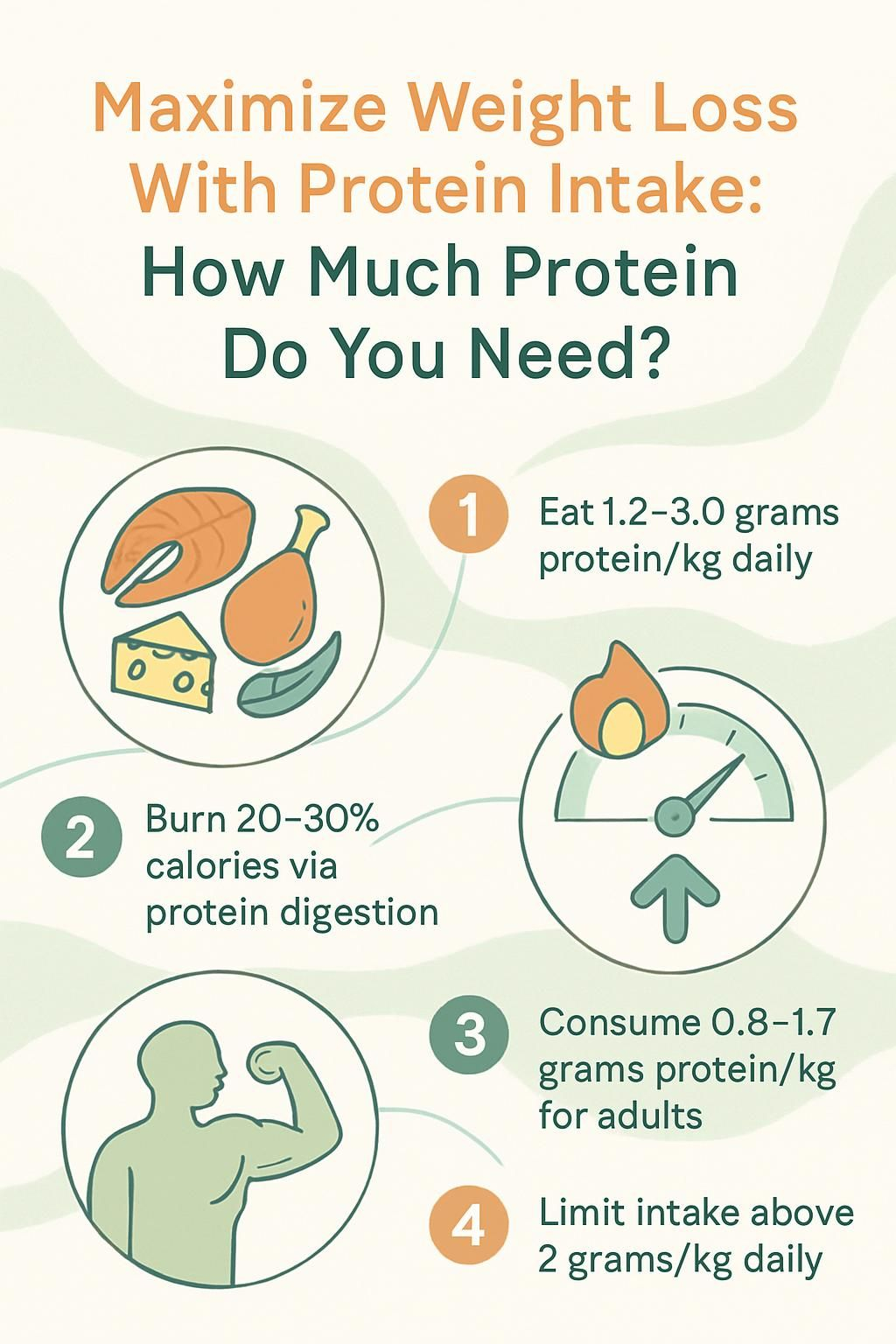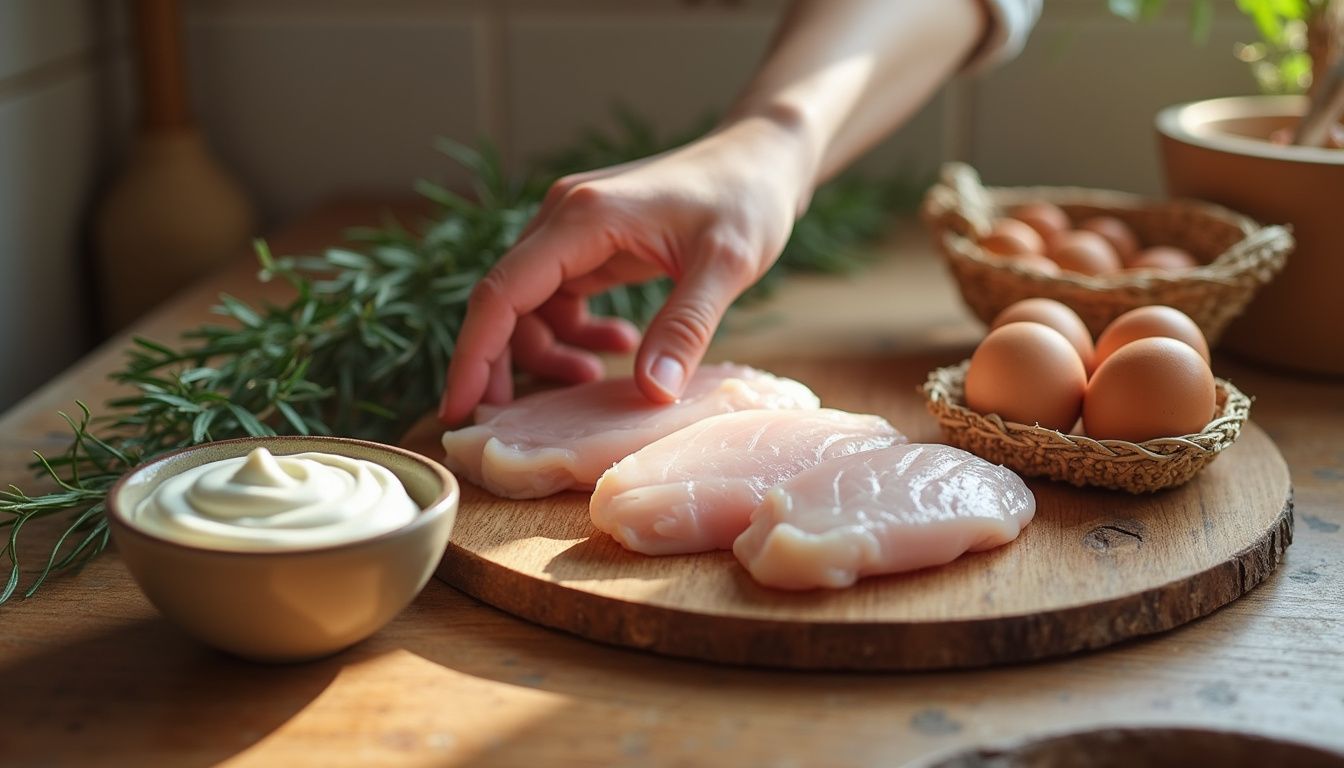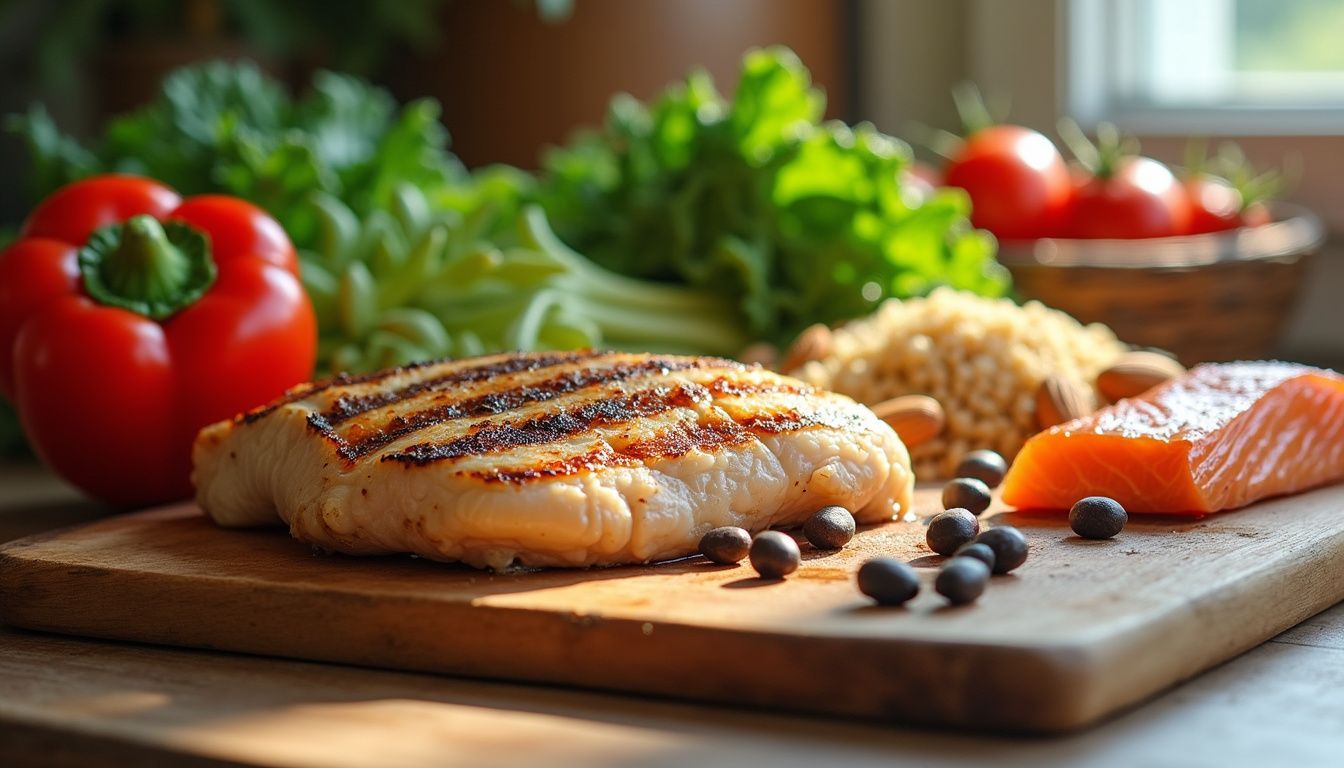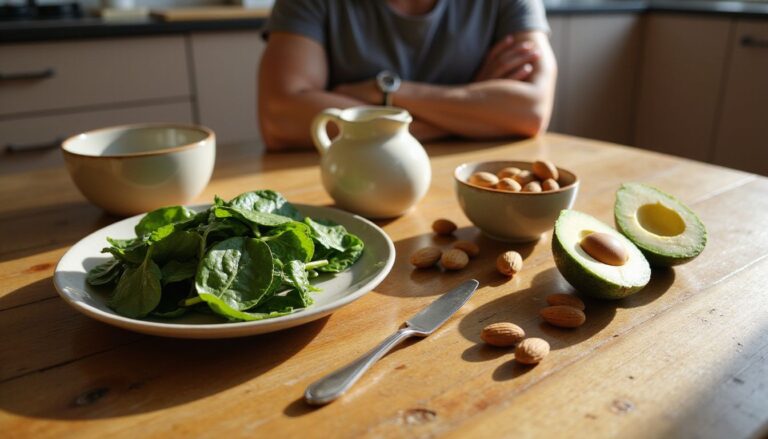Maximize Weight Loss With Protein Intake: How Much Protein Do You Need?
Our Nutrition Assistant AI Suite will transform your body. You will lose fat, get toned, and build muscle. Gain confidence and optimal health.
Trying to lose weight and not sure if you get enough protein? Protein intake plays a central role in weight loss. It helps control hunger, supports metabolism, and protects muscle while you eat fewer calories. Understanding how much protein you need, and where to get it, can make your plan easier to follow.
This guide shows how much protein per day fits your goals using research and expert advice. You will learn simple ways to add high-protein foods to meals and snacks. You will also see how to time your servings for better results.
Set a clear target, build meals around it, and you will see steady progress.
Key Takeaways
- A daily target of 1.2 to 2.0 grams of protein per kilogram of body weight helps preserve muscle and supports metabolism during calorie restriction, based on NASM guidance and clinical studies.
- Protein has a higher thermic effect, or digestion cost, than other macronutrients. About 20 to 30 percent of protein calories are burned during digestion, compared with roughly 5 to 10 percent for carbs and up to 3 percent for fat.
- The RDA is 0.8 grams per kilogram per day for adults. Many adults over 40, and those who train, do better in the 1.0 to 1.7 grams per kilogram range.
- Choose complete proteins from lean meats, fish, eggs, and dairy, and include plant options like lentils and soy. These foods make it easier to meet goals while managing calories.
- Very high intakes above 2.0 grams per kilogram may be risky for people with kidney disease. If you have health concerns, talk with a healthcare professional first.

How Protein Supports Weight Loss

Protein supports weight loss in three big ways. It raises calorie burn slightly, increases fullness after meals, and helps you keep muscle while losing fat. Keeping muscle matters because it helps maintain a higher metabolic rate.
How does protein affect metabolism?
Protein boosts metabolism through the thermic effect of food, the energy your body spends digesting and processing food. Protein costs more energy to digest than carbs or fats.
Research from NASM reports that 20 to 30 percent of protein calories are burned during digestion. Carbs use about 5 to 10 percent, and fat uses roughly 0 to 3 percent. A higher protein meal, such as eggs and yogurt, makes your body work a bit harder and burn a few extra calories.
Enough protein also helps you maintain muscle during a diet, which supports your resting metabolism. Some studies show people on higher protein plans can burn around 100 more calories per day than those on lower protein diets.
A high-protein diet is usually linked with greater calorie expenditure.
Focus on lean poultry, fish, dairy, and plant proteins. These choices make it easier to hit your protein goal without overshooting calories.
How does protein increase feelings of fullness?
Protein increases fullness by raising satiety hormones, such as peptide YY and GLP-1. These hormones tell your brain that you have eaten enough, so cravings drop and portions stay in control.
Starting the day with protein helps many people avoid snacking later. For example, swapping cereal for eggs or Greek yogurt often reduces hunger through the afternoon. Protein also slows stomach emptying, so you feel satisfied longer.
Diets that provide about 25 to 30 percent of calories from protein tend to improve fullness more than low-protein diets. Stable hunger makes it easier to stick with your plan.
How does protein help preserve muscle during fat loss?
Your muscles depend on amino acids, the building blocks of protein, to repair and stay strong. During a calorie deficit, higher protein protects lean tissue so more of the weight you lose comes from fat instead of muscle.
Aim for 1.2 to 2.0 grams per kilogram of body weight while dieting. Pair this with strength training for even better results. Many people notice they look leaner and feel stronger when they keep protein high during fat loss.
How Much Protein Do You Need for Weight Loss?
Your daily protein intake shapes how well you lose fat and keep muscle. A clear number helps you plan meals and measure progress with confidence.
What are general protein intake guidelines?
The Recommended Dietary Allowance sets a minimum of 0.8 grams per kilogram per day for adults. This level prevents deficiency, but it is modest for weight loss or muscle maintenance.
Protein can reasonably make up 10 to 35 percent of your daily calories. A 150 pound adult, about 68 kilograms, should treat 55 grams as a floor, then adjust upward based on goals and activity.
Choose complete proteins, such as poultry, eggs, dairy, and seafood. Round out your menu with plant sources like beans, lentils, and quinoa to improve fiber and nutrient intake.
Following RDA guidelines gave me a baseline, but I felt fuller and trained better after raising protein with foods like chicken breast and Greek yogurt.
How do protein needs vary by weight and goals?
Protein targets depend on your body weight, age, and activity level. Use the ranges below to set a smart starting point, then fine-tune with your results.
| Body Weight (Pounds) | Body Weight (Kilograms) | Goal / Activity Level | Recommended Protein Intake (g/kg) | Total Intake (Grams/Day) | Notes |
|---|---|---|---|---|---|
| 150 | 68 | General weight loss (Adults under 40) | 0.8-1.0 | 55-68 | Minimum for health |
| 165 | 75 | Age 40-50 (Preventing muscle loss) | 1.0-1.2 | 75-90 | Supports sarcopenia prevention |
| 180 | 82 | Weight training / Athletes | 1.2-1.7 | 98-140 | Muscle preservation and repair |
| 200 | 91 | High performance or event prep | 1.5-1.7 | 137-155 | Supports intense training |
| Any | Any | Excessive intake | Over 2.0 | 180+ (for 90 kg) | May increase kidney stress |
- Protein targets rise as muscle-building or performance demands increase.
- Adults over 40 often need 1.0 to 1.2 g/kg to offset age-related muscle loss.
- Lifters and athletes usually do best with 1.2 to 1.7 g/kg for recovery and maintenance.
- More than 2.0 g/kg is rarely helpful, and it may add strain in at-risk groups.
Use these ranges to match your goal, schedule, and training. For example, if you start strength training in your late 40s, moving to about 1.2 g/kg often improves fat loss and muscle tone.
Do protein requirements differ for women and men?
Women and men can have different protein needs due to body size, muscle mass, and energy use. Men usually need more total grams since they tend to be larger and carry more muscle.
Women’s needs change with life stages like pregnancy or menopause. During these times, aim for steady protein at each meal to protect muscle and manage appetite. Following the Dietary Guidelines for Americans helps both women and men set a reliable baseline.
Protein Intake for Different Activity Levels
Your activity level guides how much protein to eat each day. Match intake to your routine so you get enough to recover, but not so much that calories creep up.
Protein needs for sedentary individuals
If you are mostly inactive, 0.8 grams per kilogram of body weight per day fits most adults. A 165 pound person, about 75 kilograms, would need around 60 grams daily to support basic repair and health.
Get protein from eggs, milk, chicken, beans, tofu, or lentils. Protein bars or shakes can help if you miss targets, but most people can meet needs with regular meals. Eating far above this range adds calories without clear benefit for a sedentary lifestyle.
Protein needs for moderately active individuals
If you exercise several times a week but are not a competitive athlete, aim for 1.1 to 1.5 grams per kilogram per day. A 70 kilogram person, about 154 pounds, would target 77 to 105 grams.
This supports muscle maintenance and recovery from brisk walks, cycling, classes, or casual sports. Many people find that adding lean poultry at lunch or a scoop of plant-based protein in a smoothie keeps them full longer after workouts.
Protein needs for highly active individuals and athletes
Highly active people and athletes need more protein to repair tissue and support muscle growth. Set intake between 1.2 and 1.7 grams per kilogram of body weight.
For a 68 kilogram athlete, aim for 82 to 116 grams per day. Good choices include lean meats, fish, Greek yogurt, beans, lentils, and soy. Intakes above 2.0 g/kg often add strain in people with kidney disease, so adjust with care. If you have extra body fat, calculate using adjusted body weight to avoid overshooting.
Best Sources of Protein for Weight Loss
Choosing protein sources with strong nutrition and reasonable calories makes weight loss smoother. Combine animal and plant options to hit your number and support health.
What are the best animal-based protein sources?
Animal proteins are complete, meaning they contain all essential amino acids. They often provide more protein per serving, which helps you meet daily targets with less volume.
- Egg whites supply about 11 grams per 100 grams, with very few calories or fat.
- Fish such as salmon, cod, and tilapia provide roughly 20 to 25 grams per 100 grams. Many fish also contain omega-3 fats that support heart health.
- Skinless chicken or turkey offers around 23 to 27 grams per 100 grams with low saturated fat.
- Low-fat dairy, such as Greek yogurt, cottage cheese, and skim milk, provides 8 to 10 grams per cup plus calcium.
- Lean beef cuts like sirloin deliver 22 to 26 grams per 100 grams along with iron and zinc.
- Pork tenderloin gives about 21 to 23 grams per serving and less saturated fat than fattier cuts.
- Canned tuna in water works well for quick salads and sandwiches. It is budget-friendly and high in protein.
These foods help shift more of your daily calories to protein rather than carbs or fat, which supports body composition goals.
What are the best plant-based protein sources?
Plant options can meet your entire protein goal when you plan with variety. Many also deliver fiber, which supports fullness and steady blood sugar.
- Soy foods like tofu, tempeh, and edamame are complete proteins. One cup of cooked edamame has about 18 grams.
- Lentils supply around 18 grams per cooked cup and are rich in fiber.
- Beans such as black beans, chickpeas, pinto beans, and kidney beans provide about 15 grams per cooked cup.
- Nuts including almonds, peanuts, and pistachios provide 5 to 7 grams per ounce with healthy fats.
- Seeds like chia, hemp, pumpkin, and sunflower provide up to 10 grams per three tablespoons for hemp.
- Whole grains such as quinoa offer about 8 grams per cooked cup and a balanced amino acid profile.
- Seitan, made from wheat gluten, delivers about 25 grams per three ounces and has a meaty texture.
Many people notice better energy and digestion after switching some lunches to lentil bowls, chili, or bean salads. Mix plant sources across the day to cover all amino acids with ease.
When should you consider protein supplements or powders?
Packed schedules make whole-food protein tough at times. If you struggle to meet needs due to training, travel, or work, a protein shake or bar can help fill the gap.
Choose products with 2 grams or less of saturated fat, 5 grams of sugar or fewer, and under 200 calories per serving. Whole foods still matter for vitamins and minerals, so view supplements as a backup, not your main source.
Timing and Distribution of Protein Intake
Protein works best when you spread it throughout the day. This pattern supports steady energy, better recovery, and fewer evening cravings.
Why eat protein at every meal?
Even distribution keeps your metabolism active and helps you feel full from breakfast through dinner. Many people eat most of their protein at night, which leaves gaps earlier in the day.
Add a quality protein at breakfast and lunch, such as eggs, Greek yogurt, cottage cheese, or tofu. Many readers report fewer afternoon cravings when they do this.
How much protein should you have post-workout?
After training, your muscles are ready to repair. Research suggests 15 to 30 grams of protein in your post-workout meal or shake is enough for most adults. More than 40 grams at one time usually does not add extra benefit.
Try a whey or soy shake, Greek yogurt with nuts, or a salad topped with grilled chicken. Adjust the dose based on your size and training load, but stay within the recommended range for comfort and results.
How should you space protein intake throughout the day?
Plan your daily total, then split it into even servings. This keeps muscle protein synthesis, the body’s building process, active across the day.
- Aim for 20 to 30 grams of protein at each main meal.
- Include protein in snacks, such as yogurt, nuts, or a small shake.
- Use a free protein calculator to set an accurate total, then divide it by meals.
- Mix animal and plant proteins to improve variety and nutrients.
- Have one serving after workouts, then space the rest across the day.
- Avoid saving most of your protein for one large dinner.
- If you have kidney disease or take medication that affects protein needs, speak with your physician about meal spacing.
- Track your intake for a week to spot low-protein gaps and fix them.
- Active people may prefer slightly larger doses after training, with steady portions at other meals.
- Use a simple journal or app to compare your plan with your actual intake.
Benefits of High-Protein Diets for Weight Loss
Higher protein can be a steady hand on the wheel during fat loss. It supports muscle, eases hunger, and raises digestion cost slightly.
How do high-protein diets improve body composition?
When calories drop, your body may use both fat and muscle for energy. Raising protein to 1.2 to 1.6 grams per kilogram supports muscle retention so more of the loss comes from fat. Some studies show that getting at least 25 percent of daily calories from protein improves fat loss while protecting muscle.
Protein also has a higher thermic effect, so your body burns more calories breaking it down. Many people find they are less hungry when meals are protein rich, which makes portion control easier.
Can high-protein diets reduce cravings and hunger?
Yes. Protein affects hunger hormones like ghrelin and peptide YY. People who eat more protein often consume hundreds fewer calories without strict rules or tracking every bite.
Smart snacks help. Greek yogurt, cottage cheese, nuts, or a small shake between meals can lower cravings for chips and sweets.
How do high-protein diets support long-term weight management?
Protein helps maintain muscle, which keeps resting calorie burn higher. It also reduces hunger and daily snacking. These effects make it easier to maintain weight after a diet ends.
Use a simple guide: include a palm-sized portion of protein at each meal, such as chicken, beans, or fish. Many people report steadier energy and fewer cravings when they do this consistently.
Risks of Excessive Protein Intake
Eating far more protein than you need can bring trade-offs. If you have health conditions, especially kidney disease, get medical advice before pushing intake higher.
Can high protein intake strain your kidneys?
Healthy kidneys can usually handle higher protein intake. Your body breaks down protein into waste products that your kidneys filter. Current research shows no harm in healthy adults who raise protein for weight loss or training.
If you have chronic kidney disease or reduced kidney function, excess protein may add strain. Follow your clinician’s guidance and keep intake within a safe range.
What is the impact of protein on calcium loss and bone health?
High protein can increase calcium loss in urine. Some worry this might weaken bones. Evidence is mixed. People who get enough calcium and eat plenty of fruits and vegetables generally do not see harm to bone health.
The key is balance. Build meals that include calcium sources like dairy or fortified alternatives. This supports bones while you enjoy the benefits of protein.
How to balance protein with other macronutrients?
Build plates that include protein, carbohydrates, and healthy fats. A simple pattern works well: half the plate vegetables or fruit, one quarter lean protein, and one quarter whole grains like brown rice or quinoa.
Balanced meals support weight loss better than focusing on a single nutrient. Pair protein with fiber-rich foods to boost fullness and steady energy.
Tips to Increase Protein Intake
Small changes add up. Use these ideas to raise protein without driving calories too high.
How can you add protein to every meal?
Use quick swaps and easy add-ons. Plan for one protein anchor at each meal, then build around it with produce and whole grains.
- Add one or two hard-boiled eggs to breakfast with fruit for 12 to 19 grams of protein.
- Include Greek yogurt at breakfast or as a snack for about 10 to 17 grams per serving.
- Choose lean meats. A 3 ounce chicken breast with rice and vegetables gives roughly 25 grams.
- Use beans in burritos, soups, or salads. An egg and bean wrap plus a glass of milk can reach about 28 grams.
- Swap chips for cottage cheese, nuts, or low-fat string cheese.
- Feature lentils, chickpeas, or tofu in salads, stir-fries, and wraps.
- Blend a post-workout smoothie with protein powder and milk or water.
What are good high-protein snacks?
Pick snacks that satisfy and fit your calorie budget. Keep a few ready options on hand to avoid impulse choices.
- Greek yogurt, 15 to 20 grams per cup, pairs well with berries or nuts.
- Cottage cheese, about 14 grams per half cup, works plain or with fruit.
- Almonds or pistachios, around 6 grams per ounce, provide healthy fats.
- Pumpkin or sunflower seeds, about 7 to 9 grams per ounce, travel well.
- Hard-boiled eggs, 6 grams each, make a simple portable snack.
- Deli turkey slices, 10 to 12 grams per two ounces, need little prep.
- Roasted chickpeas, about 6 grams per half cup, add crunch.
- Low-fat string cheese offers 6 to 8 grams per stick.
- Protein shakes or bars with at least 15 to 20 grams help on busy days.
Keeping one or two of these options nearby can bridge long gaps between meals and curb cravings.
How to effectively use protein shakes or bars?
Shakes and bars are tools, not a full plan. Use them when you cannot prepare a balanced meal or right after a workout.
- Pick items with 2 grams or less of saturated fat, 5 grams of sugar or fewer, and about 200 calories or less.
- Use 15 to 25 grams of protein after exercise to support recovery.
- Replace a small meal or snack with a bar on busy days to cap calories.
- Scan ingredient lists and favor simple formulas.
- Pair a bar with a piece of fruit if you need extra energy.
- Keep a cold shake in an insulated bottle for easy access on the go.
- Track supplement protein so your total daily intake stays within target.
Using a Protein Calculator to Determine Your Needs
A protein calculator gives a quick estimate based on your stats and goals. It helps turn a general rule into a personal target.
How do you use a protein intake calculator?
Start with your weight and activity level. Then adjust for your goals, such as fat loss or muscle gain, and any health conditions.
- Enter your body weight in pounds or kilograms.
- Add age and gender, since needs vary by both.
- Select your activity level, from sedentary to highly active.
- Choose your goal, such as maintenance, fat loss, or muscle gain.
- If you carry extra body fat, use adjusted body weight to avoid overestimating needs.
- Review the output in grams per day and grams per meal. Many weight loss ranges fall between 0.6 and 1.0 grams per pound of adjusted body weight.
- If you have medical concerns, confirm the number with a registered dietitian or clinician.
- Use the result to plan meals and track intake so you protect muscle while you lose fat.
How to adjust protein goals based on your personal objectives?
Your protein goal should reflect your age, size, training, and how your body responds. Review your progress and adjust in small steps.
- During calorie restriction, raise protein to protect muscle and improve satiety.
- For fat loss or muscle maintenance, aim for 0.7 to 1.0 grams per pound of adjusted body weight.
- For muscle gain phases, move up to as high as 1.2 grams per pound, if tolerated.
- Scale intake to match activity. Less active people can use the low end of ranges.
- Older adults often need higher targets to offset age-related muscle loss.
- Track food and check weekly trends in hunger, energy, and body measurements.
- Seek professional guidance if you have kidney disease or other health issues.
- If you feel strong and satisfied, you are likely close to the right target. If not, adjust in 10 to 15 gram steps.
- Update your goal when your training load or body weight changes.
Common Myths About Protein and Weight Loss
Clear up these myths so you can focus on what works.
Does eating too much protein cause weight gain?
Your body cannot store extra protein in a special tank. If you eat more calories than you burn, even from protein, your body can store the excess as fat. A big jump in shakes or bars without cutting other calories can lead to slow weight gain.
Watch the whole day’s calories, not only the grams of protein. Balance matters.
Is protein only useful for building muscle?
Protein supports far more than muscle size. It helps you feel full, maintains skin and hair, and supports enzymes that drive metabolism. Eating enough protein can also slightly raise daily calorie burn due to its higher digestion cost.
During weight loss, this combination helps you keep strength and energy while eating fewer calories.
Are plant proteins inferior to animal proteins?
Plant proteins can meet your needs when eaten in variety. Soy is complete on its own. Beans, lentils, nuts, seeds, and whole grains can cover all essential amino acids across a day.
The Academy of Nutrition and Dietetics supports well-planned vegetarian diets for both weight loss and maintenance. Many people thrive by pairing foods like lentils with rice or adding seeds to oatmeal.
Protein in Popular Diet Plans
Many plans use a higher protein pattern to control hunger and protect muscle. The right plan depends on your preferences and health status.
What are high-protein, low-carb diets?
These diets raise protein while cutting carbs like bread, pasta, and rice. Plates often feature eggs, fish, chicken breast, tofu, or lean beef with vegetables and healthy fats.
Many people feel fuller and snack less. If you choose this style, include fiber-rich vegetables and heart-healthy fats to round out nutrition.
What are plant-based high-protein diets?
Plant-forward plans center on beans, lentils, soy foods, quinoa, and whole grains. These foods are lower in saturated fat and high in fiber. Lentils provide about 18 grams per cup, and edamame provides about 17 grams per cup.
Switching meat for lentil chili or chickpea salads often improves fullness without many extra calories. Soy foods help cover all essential amino acids with ease.
What are balanced macronutrient diets?
Balanced plans include all three macronutrients. Many people do well with protein at 10 to 35 percent of daily calories, paired with whole grains and healthy fats. This approach supports steady energy and consistent weight loss.
For example, a plate with grilled chicken, brown rice, and a large salad fits the model and keeps you satisfied.
Monitoring Your Progress with Protein Intake
Track your protein so you can compare plans with results. Small course corrections keep momentum going.
How do you track your protein consumption?
Pick one method and use it daily for at least a week. Consistency matters more than the tool you choose.
- Use a food diary app like MyFitnessPal or Cronometer to log meals and see protein totals.
- Check nutrition labels for protein per serving.
- Weigh or measure proteins such as meat, dairy, eggs, and beans for accuracy.
- Use pen and paper if you prefer a notebook, then total protein after each meal.
- Aim for 15 to 30 grams at each meal and compare your entries to this target.
- Set a daily goal with a calculator and track progress against it.
- Review weekly data to spot low-protein meals or snacks.
- Add quick fixes like yogurt or turkey slices if your totals fall short.
When and how should you adjust protein intake during weight loss?
Adjust when your weight, training, or hunger changes. Fine-tuning keeps your plan effective and comfortable.
- Increase to 1.0 to 1.2 g/kg if you are 40 to 50 or older to counter muscle loss.
- Raise protein if hunger grows during a deficit. Higher protein helps control appetite.
- Increase intake as training volume or intensity rises to protect muscle.
- Lower calories while keeping protein high if weight loss stalls. Aim for 25 to 30 percent of calories from protein.
- Rotate sources like eggs, dairy, tofu, beans, and fish to hit targets without extra calories.
- Recalculate after every 10 pound loss. You may need slightly less total protein as body weight drops.
- Consult a clinician before major changes, especially with kidney disease or other conditions.
- Many people break plateaus by adding a bit more protein and lifting twice per week.
Conclusion
Protein is the backbone of a weight loss plan that protects muscle and curbs hunger. Set a daily protein goal, usually between 0.8 and 1.7 grams per kilogram of body weight, then spread it across breakfast, lunch, dinner, and snacks. Choose lean meats, fish, eggs, dairy, and plant proteins like beans, lentils, soy, and quinoa.
Your needs depend on age, activity level, and health status. If you have kidney disease, are pregnant, or take medications that affect protein metabolism, talk with a qualified healthcare professional before making big changes. Keep tracking, adjust in small steps, and let steady habits do the work.
With the right amount of protein and consistent meals, you can lose weight, keep strength, and feel satisfied day to day.
FAQs
1. How much protein should I eat daily to support weight loss?
Research suggests that adults aiming for weight loss may benefit from consuming 0.6 to 0.8 grams of protein per pound of body weight each day. For example, a person weighing 150 pounds would need about 90 to 120 grams of protein daily (Leidy et al., 2015). This amount helps preserve muscle while losing fat.
2. Why does eating more protein help with losing weight?
Protein increases feelings of fullness and reduces hunger, which can lead to fewer calories eaten throughout the day (Paddon-Jones et al., 2008). It also supports muscle maintenance during calorie restriction, helping your metabolism stay active.
3. What are some high-protein foods that fit into a healthy diet plan?
Lean meats like chicken breast or turkey, fish such as salmon or tuna, eggs, Greek yogurt, cottage cheese, tofu, and legumes like lentils provide rich sources of dietary protein with low saturated fat content.
4. Can too much protein cause health problems when trying to lose weight?
Most healthy adults tolerate increased dietary protein without harm if kidney function is normal (Phillips et al., 2016). However, extremely high intake over long periods may stress kidneys in those with pre-existing conditions; moderation remains important.
Summary: Eating enough quality protein each day supports effective fat loss by preserving lean tissue and controlling appetite. Choosing lean animal proteins or plant-based options ensures nutritional balance while reducing excess calories from fats or sugars. Personal experience shows that tracking daily intake using a food diary helps maintain consistency and reach goals safely and efficiently.
References:
– Leidy HJ et al., Am J Clin Nutr (2015)
– Paddon-Jones D et al., Curr Opin Clin Nutr Metab Care (2008)
– Phillips SM et al., Appl Physiol Nutr Metab (2016)







